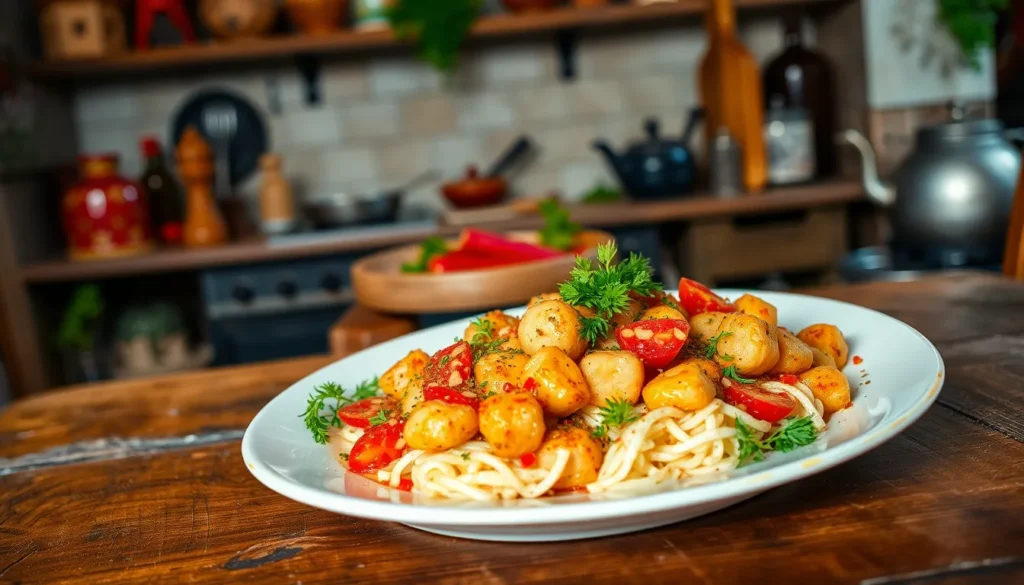Table of Contents
ToggleIn the vast world of culinary delights, few dishes can claim the same level of intrigue as falotani. Imagine a tantalizing blend of flavors and textures that dances on the palate, leaving taste buds begging for more. This dish isn’t just food; it’s an experience, a story wrapped in spices and served with a side of culture.
But what exactly is falotani? It’s the kind of dish that makes you wonder why you haven’t tried it sooner. Whether you’re a seasoned foodie or just someone looking to spice up dinner, falotani promises to deliver a delightful adventure. So, buckle up and prepare to explore the delicious nuances of this vibrant dish that’s sure to become a staple on your table.
What Is Falotani?
Falotani embodies a unique dish recognized for its rich flavors and textures. This culinary experience tells a cultural story, inviting food enthusiasts to explore its delightful aspects.
Origin and History
Falotani traces its roots back to the heart of its originating region, where ancient traditions influenced its creation. Historical accounts show that local ingredients shaped the dish, giving it distinctive characteristics. Over centuries, falotani evolved through various cooking techniques, allowing families to pass down recipes. Cultures integrated unique spices, enhancing the dish’s flavor profile. Regions celebrated falotani during significant festivals, showcasing its importance within culinary heritage. These historical ties reflect the story of the people who cherish it.
Cultural Significance
Falotani holds immense cultural significance, serving as a symbol of community and tradition. In many neighborhoods, sharing this dish fosters bonds among families and friends. Social gatherings often center around falotani, making it a staple during celebrations and communal meals. Its preparation showcases time-honored practices, connecting generations through shared culinary experiences. Additionally, falotani encourages the use of local produce, supporting regional agriculture. This dish not only represents a meal but also embodies a cultural identity, preserving heritage through flavors.
Types of Falotani

Falotani encompasses various types, showcasing regional adaptations and unique ingredient combinations. Each variation offers a distinct taste profile, celebrating its cultural origins.
Regional Variations
Regional variations of falotani reflect local traditions and available ingredients. In coastal areas, seafood dominates, infusing the dish with fresh, salty flavors. Inland regions often include meats like lamb or goat, highlighting agrarian practices. Urban centers may feature fusion interpretations, merging international flavors with traditional recipes. Certain festivals celebrate specific falotani variations, honoring cultural heritage through distinct preparation methods. Community impact illustrates how each region proudly defines its culinary identity.
Common Ingredients
Common ingredients in falotani contribute to its rich flavor and texture. Spices like cumin, coriander, and turmeric form the foundational taste profile, enhancing overall complexity. Fresh herbs, such as cilantro and parsley, provide brightness and depth. Vegetables, including bell peppers and onions, deliver essential nutrients and texture. Proteins such as chicken, lamb, or lentils cater to varying dietary preferences. Grains such as rice or couscous often serve as the base, creating a hearty meal. These ingredients unite to create a memorable dining experience that transcends mere sustenance.
How To Prepare Falotani
Preparing falotani involves careful attention to ingredients and cooking techniques. Each step adds layers to its rich flavor profile.
Step-by-Step Guide
- Gather essential ingredients: spices, fresh herbs, vegetables, and your choice of proteins such as lamb or seafood.
- Prepare the base: sauté onions, garlic, and ginger in olive oil until fragrant. This forms a flavorful foundation.
- Add vegetables: toss in vegetables like bell peppers or carrots along with spices like cumin and coriander. Ensure even cooking.
- Introduce protein: depending on preference, add marinated meat or seafood. Cook until tender and fully integrated with the flavors.
- Cook grains: prepare accompanying grains, typically rice or couscous, infused with spices for added depth.
- Combine and serve: merge everything together, allowing flavors to meld. Garnish with fresh herbs for an authentic touch.
Tips for Authentic Flavor
Using high-quality spices elevates the dish’s taste. Explore local sources for spices that are fresh and vibrant. Incorporating seasonal vegetables enhances nutritional value and flavor complexity. Marinating proteins overnight deepens the flavors, making the dish more memorable. Adjust spice levels based on personal preference for the perfect balance. Always serve falotani hot, allowing guests to enjoy its full aroma and taste.
Serving Suggestions
Serving falotani invites creativity and enhances the dining experience. This dish pairs well with a variety of accompaniments.
Pairing with Other Dishes
Falotani complements salads, offering freshness and crunch. Dishes like tabbouleh or a simple cucumber salad enhance its flavors. Grilled vegetables bring smoky notes that contrast beautifully with falotani’s spices. Serving it alongside rice or couscous creates a hearty meal. A selection of flatbreads enriches the experience, perfect for scooping up the dish. Including a side of yogurt or tzatziki adds creaminess that balances the spice. Each option deepens the meal’s flavor profile, making every bite satisfying.
Popular Drinks to Accompany
Refreshing beverages elevate falotani for an enjoyable meal. Mint tea stands as a traditional favorite, enhancing the dish’s aromatic qualities. Sparkling water with lemon provides a crisp counterbalance to the spices. For those seeking a heartier option, a light red wine complements the dish’s rich flavors. Non-alcoholic choices, like hibiscus iced tea, cater to varying preferences while adding a hint of tartness. Each drink heightens the overall experience, encouraging diners to savor the moment.
Falotani stands as a testament to the rich tapestry of culinary heritage. Its ability to bring people together during celebrations and everyday meals highlights its significance beyond just food. With every bite, one experiences not only a blend of flavors but also a connection to traditions that have been cherished through generations.
Exploring falotani opens doors to understanding diverse cultures and regional variations. Whether it’s through traditional recipes or modern adaptations, this dish continues to evolve while maintaining its essence. Embracing falotani in one’s kitchen not only enriches the dining experience but also honors the stories and communities behind it.







